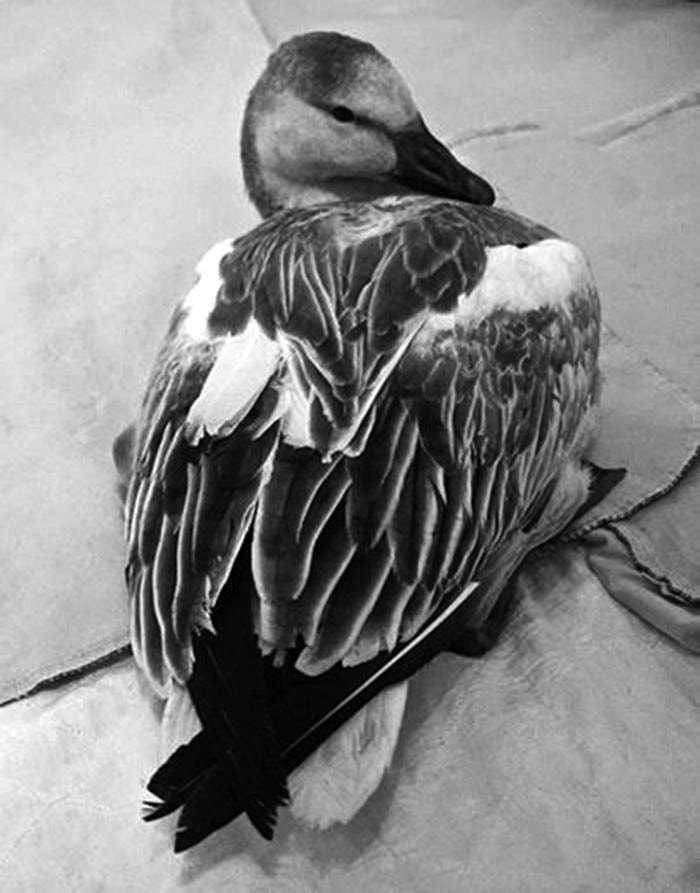S
o often lately we hear about wildlife species that are in trouble or decline, that it is encouraging to write about a bird that is thriving and its populations rising.
In nature many species have had to learn to adapt to an ever-changing environment and some, like the snow geese, have taken advantage of recent changes that have provided them with new breeding and feeding areas during the summer months.
Snow geese are the most abundant geese in Canada and are found right across the northern Arctic using a variety of migratory routes to their winter feeding grounds in the southern United States and Canada.
The largest wintering area in British Columbia for the snow geese is in and around the Fraser River Delta; to observe this phenomenon you should visit the Reifel wildlife sanctuary in Delta, where huge flocks of snow geese rest up and prepare for the breeding season.
Smaller than the Canada goose, snow geese weigh between 2.2 and 2.7 kilograms, the male being larger than the female. There are two distinct 'colour phases' (polymorphism or genetic variation found in snow geese).
The white phase is most common; these birds are pure white except for black wingtips; the black feathers contain more pigment providing them with greater wear and tear.
These geese have pink legs, the bill is pinkish orange with a black smile line; the orange comes from the iron-rich waters they feed in. Blue phase geese have white heads, bluish-coloured lower backs and flanks, and their wings graduate from pale grey to almost black; white phase goslings are yellow, the blue phase are black.
The unique features of these geese are their strong bills and tongues; both are equipped with serrated edges to prevent their mouths being cut by the food they eat.
Dining mainly on aquatic vegetation, plant roots, sedges and grasses, they won’t say no to root crops left in farmers fields.
Within the next few weeks more and more geese and swans will be arriving. Their stay is a short one before they have migration on their minds again.
Huge flocks spend their summers over 4,000 kilometres north on Wrangle Island in the Arctic. Before making the northern migration they must accumulate enough body fat to enable them to survive upon arrival, in case the snow has not thawed.
As soon as the snow has melted, the geese lay their eggs. An average clutch is four. They reuse the previous year’s nests, making any necessary repairs.
If spring arrives late into June, the females reabsorb the unlaid eggs and will try again in the next season. Goslings are able to feed and swim as soon as their feathers are dry from hatching.
Their hatching usually coincides with an abundance of protein-rich insects, which they eat for two weeks before moving on to a variety of vegetation.
Strong family bonds keep the group together for the first year, a time for passing on life and survival skills. Although these geese are very visible in the Delta area, few call the Comox Valley their winter home. Usually all we see is the occasional bird that has tired and leaves the flock to hopefully feed and gain enough reserves to complete the migration.
Our recent visitor – only the second I have seen in our centre in seven years – is very thin was unable to sustain flight. The goose was cared for, and became healthy and strong, resulting in a release earlier this week.
It is good to be aware of certain things when seeing migratory birds that have fallen short of their wintering grounds. Snow geese are especially prone to diseases, as they travel in huge flocks and pass intestinal diseases that render them weak and unable to regain their stamina or fly.
Always call for advice on how to help an injured or sick bird; MARS has specially trained personnel that know what precautions need to be taken as some diseases can be transmitted to humans.
In the next few weeks be on the lookout for the first trumpeter swans. Their arrival maybe delayed due to the relentless wind and rain storms we have experienced. Another great area to observe our winter migrant water fowl is the Oyster River estuary and the wetlands at Salmon Point.
To report injured wildlife please call 250-337-2021. Please visit our web site for more information at www.wingtips.org.
MARS is also looking for online votes for the AVIVA Community Challenge, which, if successful, could result in a donation of $100,000 which would go to the future expansion of the facility. The organization is in the semifinals, with the last vote resuming in December. To vote, visit www.avivacommunityfund.org and search for M.A.R.S.
Sandy Fairfield is the educational co-ordinator for the Mountainaire Avian Rescue Society (MARS). The MARS column appears every second Thursday.
